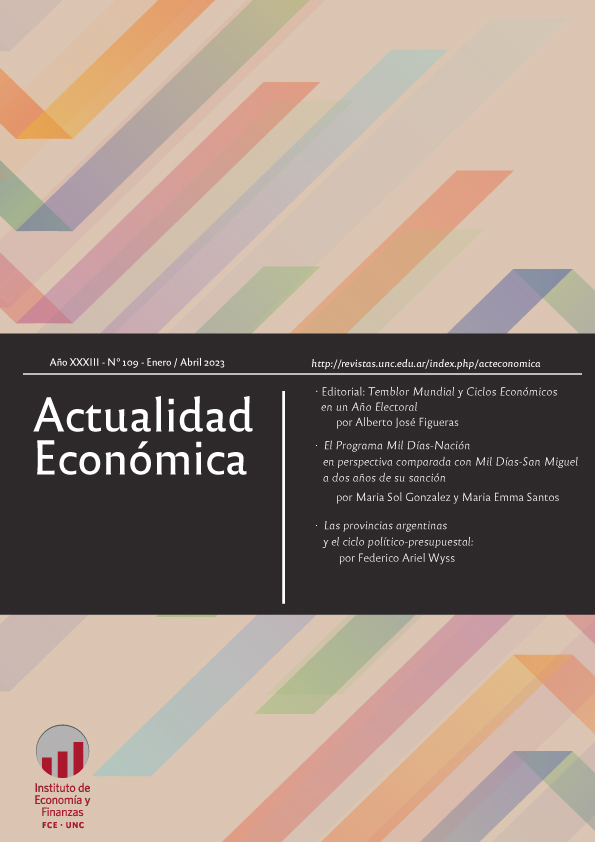Argentina's provinces and the political-budgetary cycle: an analysis in 30 years of democracy
Keywords:
Fiscal Policy, Political Economic Cycle, ProvincesAbstract
This article is about the existence of budge policy cycles in the Argentine provinces and the City of Buenos Aires during the period 1983-2004, as well as for the period when FPV was in charge of the government (2003-2014). To do that, the Generalized Method of Moments (GMM) is used, working with dynamic panel data. The results show evidence of the presence of cycles of electoral origin on the total expenditure of the provinces in both periods. In particular, for the 2003-2014 period there is a strong bias towards the current components of spending (consumer spending and current transfers), while the evidence is scarce for the case of capital spending (real direct investment). The cycle is consistently tested for all three items in the full period (1983-2014).
Downloads
References
Almaraz, G. (2010). Ambición política por la reelección en las provincias argentinas. Revista SAAP: Sociedad Argentina de Análisis Político, 4(2), 191-226.
Alt, J. y Lassen, D. (2006). Transparency, political polarization, and political budget cycles in OECD countries. American Journal of Political Science 50: 530-550.
Álvarez, B. y Cordomí, M. (2006). Manipulación electoral del gasto público: evidencia empírica en las provincias argentinas (1983-2002). Anales de la Asociación Argentina de Economía Política.
Arellano, M. y Bond, S. (1991). Some tests of specifications for panel data: Monte Carlo evidence and an application to employment equations. Review of Economic Studies 58: 277-97.
Barro, R. y Gordon, D. (1983). Rules, discretion and reputation in a model of monetary policy. Journal of monetary economics, 12(1), 101-121.
Brender, A. y Drazen, A. (2004). Political Business in new versus established democracies. Journal of monetary Economics, 52(7), 1271-1295.
Block, S. (2002). Elections, electoral competitiveness, and political budget cycles in developing countries. Harvard University CID working paper, No. 78.
Capello, M. y Diarte, G. (2013). Inversión pública en provincias argentinas en el período 2003-2011. Monitor Fiscal, año 8 N° 22. IERAL de Fundación Mediterránea.
Capello, M. y Marconi, A. (2015). Finanzas Provinciales: Evolución en últimos años. Perspectivas para 2015. Monitor Fiscal, año 10 N° 26. IERAL de Fundación Mediterránea.
Gervasoni, C. (2009). Democracia y autoritarismo en las provincias argentinas. Aportes para el Estado y la administración gubernamental, año 15 N°27.
Hibbs, D. (1977). Political parties and macroeconomic policy. The American Political Science Review, 71(4), pp. 1467-1487.
Jones, M., Meloni, O., y Tommasi, M. (2007). The Nationalization of Parties and Party Systems: An Empirical Measure and an Application to the Americas. Party Politics 9 (2): 139-166.
Kalecki, M. (1943). Political aspects of full employment. The Political Quarterly, 14(4), 322-330.
Kydland, F. y Prescott, E. (1977). Rules rather than discretion: The inconsistency of optimal plans. The journal of political Economy, 473-491.
Larrain, F. y Assael, P. (1997). El Ciclo Político Económico en Chile en el Último Medio Siglo. Estudios Públicos 68.
Lohmann, S. (1998). Rationalizing the political business cycle: A workhorse model. Economics and Politics 10: 1-17.
Medina, L. y Lema, D. (2003). Ciclos presupuestarios de origen electoral: el caso de las provincias argentinas. Anales de la Asociación Argentina de Economía Política.
Muñoz y Asociados. (2015). Indicador Sintético de Actividad de las Provincias (ISAP). Obtenido de www.isap.com.ar
Nordhaus, W. (1975). The political business cycle. Review of Economic Studies 42: 169–190.
Nuti, D. (2011). El ciclo político de Kalecki desde una óptica actual. Una introducción. Revista de Economía Crítica 12: 207-213.
Ramírez, R. y Erquizio, A. (2012). Análisis del ciclo político electoral a partir de variables de gasto público por entidad federativa en México, 1993-2009.Paradigma económico, Año 4 N°2: 5-27.
Rogoff, K. (1990). Equilibrium political budget cycles. American Economic Review 80: 21-36.
Roodman, D., 2009. A note on the theme of too many instruments. Oxford Bulletin of Economics and Statistics, 71(1), pp. 135-158.
Schuknecht, L. (2000). Fiscal policy cycles and public expenditure in developing countries. Public Choice 102: 115-130.
Schumpeter, J. (1939). Business cycles: a theoretical, historical, and statistical analysis of the capitalist process. cGraw-Hill.
Shi, M. y Svensson, J. (2006). Political budget cycles: do they differ across countries and why? Journal of Public Economics 90, 1367-89.
Spiller, P. y Tommasi, M. (2010). Un país sin rumbo. ¿Cómo se hacen las políticas públicas en Argentina? En C. Scartascini, P. Spiller, E. Stein y M. Tommassi (editores), El juego político en América Latina, ¿cómo se deciden las políticas públicas? (pp. 75-116). Barcelona: Banco Interamericano de Desarrollo.
Streb, J. y Torrens, G. (2012). Making rules credible: divided government and political budget cycles. Public Choice (DOI 10.1007/s11127-012-9923-2).
Tow, A. (2016). El Blog de Andy Tow. Obtenido de www.andytow.com
Villamarín, P. (2008). “Ciclos económicos de origen político: la visión heterodoxa de Kalecki”, Apuntes del CENES, volumen 27 N° 46.
Wikipedia. (2016). Wikipedia, la enciclopedia libre. Obtenido de es.wikipedia.org
Downloads
Published
Issue
Section
License

This work is licensed under a Creative Commons Attribution-NonCommercial-NoDerivatives 4.0 International License.
Those authors who have published with this journal, accept the following terms:
Authors will conserve their copyright and guarantee the magazine the right of first publication of their work, which will be simultaneously subject to the Creative Commons Attribution-NonCommercial-NoDerivative 4.0 International License that allows third parties to share the work as long as the author and first publication of this magazine are indicated.
Authors may adopt other non-exclusive license agreements to distribute the published version of the work (e.g., deposit it in an institutional telematic archive or publish it in a monographic volume) provided that the initial publication in this journal is indicated.
Authors are allowed and encouraged to disseminate their work through the Internet (e.g., in institutional telematic archives or on their website) before and during the submission process, which may lead to interesting exchanges and increase citations of the published work. (See The effect of open access)









